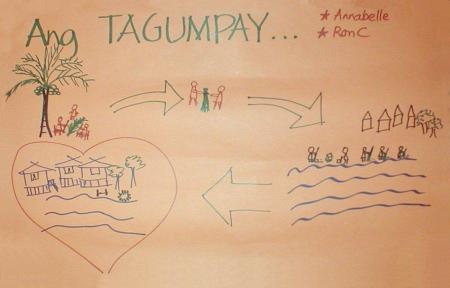Knowledge Cafe is a popular tool for creative exploration and brainstorming together – thinking processes which are more productive if participants’ right brains are more engaged. However, about 94% of people are left-brain dominant and it takes effort and different process techniques to engage their right brains.
A process technique to engage people’s right brains more is by making them draw instead of letting them do talking or writing. Talking and writing words are left-brain activities, while drawing and using images and symbols are right-brain activities.
In a Knowledge Cafe, drawing is encouraged by placing large sheets of Manila or kraft paper as well as several colored pens or crayolas on the table. Participants are free to draw as they talk and think together. If many participate in the creative thinking and drawing process, the evolution of the drawing on the tabletop makes visible to the group what they are thinking together. They are “grawing” (=group drawing)!
Grawing is more a right-brain activity while griting is more a left-brain activity. Tabletop grawing in a Knowledge Cafe is a right-brain activity, while live griting the minutes of a meeting is a left-brain activity. In the grawing-and-griting or G&G Table in the previous blog, the upper rows are more right-brain while the lower rows are more left-brain activities.
Below is the result of tabletop grawing where participants together drew their collective idea of what is “successful community development”. “Tagumpay” is the Tagalog word for “success”.

One of the participants, Annabelle, verbalized their grawing as follows (translated from Tagalog, shortened and edited while maintaining the essential ideas):
-
For us, the start of development is like making walis tingting.* [*Note: “Walis tingting” is a local broom (“walis”) consisting of about a hundred coconut midriffs (“tingting”) tied together. This coconut broom represents a well-known local metaphor for unity: one coconut midriff cannot do anything; it is powerless. But when many are tied together (unity of the community), they gain strength and efficacy.]
First, the leafy part from each coconut leaflet is removed by a knife to produce one tingting [midriff]. This is like individual discipline: it is difficult or painful but when done, it is a small success. Then many tingtings are tied together into a broom. This is community discipline and unity – a bigger success. With a broom you can clean the seashore of garbage. If the community is united and a project answers community needs – when families get their own house, land and livelihood and they can help themselves and the community – then the project is successful. However, that is not the end-all of success.
The last stage [see last arrow pointing to houses inside a heart] is when you no longer need the broom because every community member understands and respects or feel responsible for the environment, and no longer throws garbage. That is far greater success.
—
Note that there are embedded links in this blog post. They show up as colored texts. Click on a link to open (in a new tab) the webpage pointed to.
=>Back to main page of Apin Talisayon’s Weblog
=>Jump to Clickable Master Index









